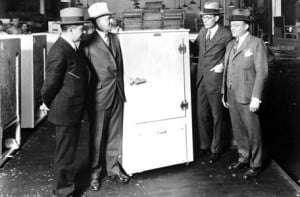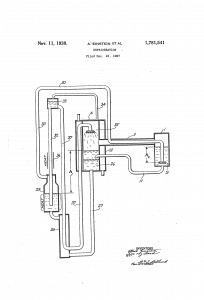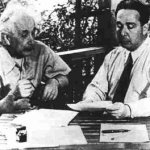In honor of Clean Out Your Refrigerator Day, celebrated on November 15th, you may want to know how your refrigerator operates.

HISTORY
Refrigerators are a modern invention. Until the advent of wide-scale electricity, keeping food cold had been a challenge for civilizations. Even as late as the 1800s, ice continued to be the major method for cooling. However, in 1848, Alexander Twining experimented with vapor-compression refrigeration allowing mechanical cooling to be applied in the meat packing and brewing manufacturing industries from the 1870s through the 1890s. Then in 1895, a German engineer, Carol von Linde, designed a process for the mass-scale production of domestic operating cooling units.1 By 1921, the first Frigidaire came off an assembly line at the Delco Light Plant of General Motors. That same year, 5,000 refrigerators were manufactured for home use.2

All refrigerator models work on the same principle: as the gas phase of matter expands, it takes up heat from the environment and converts the thermal energy to other forms of energy. This is called the Carnot cycle.3 In refrigerators, a gas is compressed and under pressure is changed to liquid. A compressor forces the liquid, or coolant, through a series of tubes or coils where it vaporizes, removing heat from the surrounding environment (i.e., from inside the refrigerator). A pump that is run by a motor sucks up the warmed gas, compresses it into liquid again, and sends it to the condenser for another bout of cooling.4 In the early twentieth century, refrigerators used methyl chloride, sulphur dioxide, or ammonia gas, all of which are toxic and caused several injuries and fatalities when leaked into homes.

INVENTION
For this reason, Albert Einstein had the idea to improve its safety. In 1926, he partnered with Leo Szilard, a Hungarian-American physicist, who had published his dissertation on thermodynamics and had knowledge of patent engineering. Together they set out to improve the mechanical compressors and eliminate the toxic gases. “The Einstein-Szilard fridge used pressurized ammonia, butane and water… and no moving parts — thereby eliminating the possibility of seal failure…One of the components the two physicists designed for their refrigerator was the Einstein-Szilard electromagnetic pump, which had no moving parts, relying instead on generating an electromagnetic field by running alternating current through coils. The field moved a liquid metal, and the metal, in turn, served as a piston and compressed a refrigerant.”5
In 1930, freon was introduced as an economically favored refrigerant gas. However, with environmental concerns over climate change and the impact of freon and other chlorofluorocarbons on the ozone layer, it maybe time for another reinvention. “Green refrigeration” is being explored. Two groups in the UK, Malcom McCullough of Oxford, is designing a solar-powered fridge as an alternative energy source, and Camfridge Ltd, in Cambridge, is researching gas-free alternatives.7 Also, a team of Canadian-Bulgarian researchers are looking into magnetic cooling.8
So as you toss out the carton of milk which expired two weeks ago, think how you might improve upon Einstein’s cooling appliance.
REFERENCES
1. McCorquodale, Duncan, et al, editors. Inventors and Inventions. London : Black Dog, 2009. p. 32 Engineering Library FOLIO T48 .I58 2009
2. Langone, John. How Things Work: Everyday technology explained. Washington D.C. : National Georgraphic Society, 2006, pages 18 – 19. Engineering Library T47 .L2923 2006
3. The Carnot Cycle (Source: MIT)
4. Wearing, Judy. Edison’s Concrete Piano: Flying Tanks, Six-Nippled Sheep, Walk-On-Water Shoes and 12 Other Flops from Great Inventors. Toronto : ECW Press, 2009, pages 231 – 232 Engineering Library T47 .W42 2009
5. The Story of Einstein’s Refrigerator by Jennifer Ouellette, December 5, 2010
6. Einstein, Albert and Szilard, Leo. Refrigeration. U.S. Patent 1,781,541, filed December 16, 1927, issued November 11, 1930. (Source: Google Patents)
7. Wearing, Judy. Edison’s Concrete Piano: Flying Tanks, Six-Nippled Sheep, Walk-On-Water Shoes and 12 Other Flops from Great Inventors. Toronto : ECW Press, 2009. pages 239 – 240. Engineering Library T47 .W42 2009
8. Magnetic Cooling Enables Efficient, ‘Green’ Refrigeration, June 19, 2014. (Source: Phys.org)
9. Standard Specification for Reach-in Refrigerators, Freezers, Combination Refrigerator/Freezers, and Thaw Cabinets. ASTM F2520-05 (2012) (Source: ASTM International)
10. Pham, Hung. Lower-GWP Refrigerants in Refrigeration. ASHRAE-D-ANRC12-17. (Source: TechStreet)
11. Energy-Efficient Refrigerator Prototype Test Results [microform]. Washington, D.C. : U.S. Environmental Protection Agency, Office of Atmospheric and Indoor Air. EPA-430-R-94-011, June 1994. Main Media Collection Microfiche EP 4.2:R 25/3